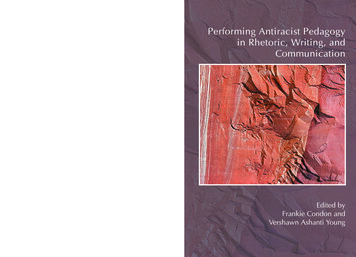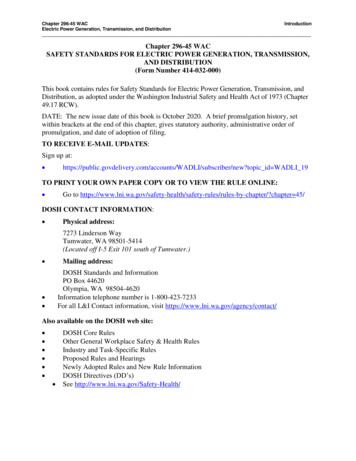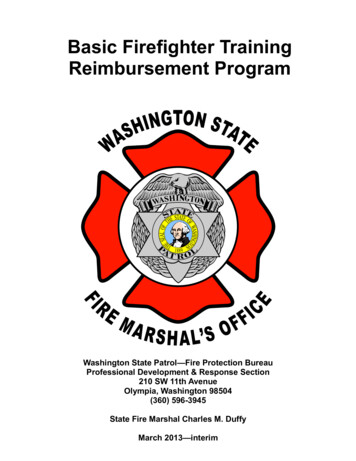
Transcription
Writing to Learn SciencePatricia JohnstonShorecrest High School, Shoreline, WashingtonEnglish and social studies teachers expect writing to play a major rolein their classes. They regularly assign and evaluate essays and researchpapers. Most science teachers I know do not think of writing as an important part of their classes. To be sure, they assign lab reports and occasionally ask students to answer questions at the end of a chapter, butwriting is not really important in their class work. Moving and caringfor delicate and expensive equipment takes a great deal of time. Thenthere is the demanding problem of preparing for laboratory sessionsand the subsequent clean-up, repair, and replacement of equipment."With all these other concerns," they say, "who has time for writing?"I used to share this view with my colleagues, but in recent years Ihave come to value writing in my classes, not just writing to show thata lab task has been accomplished, but writing to learn. What I have discovered is that writing helps my students understand science morefully than any other teaching strategy can. The learning fostered bywritten reports more than compensates for the time they require . Written reports that must be scientifically accurate, interpretive, creative,analytical, and evaluative demon strate those highly prized goals of abstract thinking which all teachers hope to foster.Arnold Arons and Robert Karplus, science professors who havestudied levels of intellectual development, state:If it is indeed true that one-third of the school popul ation is formaloperational by the age about 14 while one-third is still concrete andthat these proportions do not change substantially from then on inspite of schooling, then we face the implication that our educational system is not contributing significantly to intellectual development (abstract, logical thinking) (American Journal of Physics 1976,44) .These researchers also state that helping students to make progress inbecoming formally operational should be a major objective ofeducation.92
Writing to Learn Science93One of the first ways I use writing in my classes is to help studentslearn the vocabulary of the discipline. I do this by having students writepoems which they call biocrostics, an adaptation of the biopoem. Someserve as unit s ummary; some are just a welcome break from lectures,labs, and tests.Students are asked to produce a poem by using the letters in thename of one of the plants or animals we are studying. Biology studentsbelieve that the " bio" stems from biology and no one tells them differently. The only other rule for these poems is that each line must includesome fact about the organism which is being immortalized and, if questioned, the student must provide supporting evidence for a given line .The following examples are from a life science class which students takeas a las t resort for fulfilling science graduation requirements.Points are given for correctly using vocabulary words from the studyunit. Each statement (line) must begin with the first letter of sequencein the spelled animal name. These exercises require conceptual understandings of the basic " lifestyle" of the animal as well as creativitywithin the constraints of the letters in the name. Notice that the life science class uses the common name .Pedra SantosCLAMMollusks (CLAM)alcium PROTECTS the average BIVALVEike a HATCHET a foot gives the movemen t they havell people think the SIPHON'S the neckuscles close the shell quick to save them by heck!Todd BennettSQUIDSPhylum MolluscaSQUIDShells are VESTICLE and we call them a "pe n"uick is the movement that caves the m againnder their suckers is a toothed horny nailnk sacs protect them by making "smoke screen"ee p sea kinds are LUMINOUSLY seentrong vicious jaws make the m not like a snail.The nex t examples are from a vertebrate zoology class for which biology and chemistry are prerequisites. The class requires much readingand writing as well as laboratory projects. Only binomial nomenclatureis allowed in these biocrostics. The other rules are the same, but thecomplexity and application of higher cognitive levels are immediatelyapparent.Shannon Joplin and Carolyn GrossSTRONGYLOCENTROTUS FRANCISCANUSS eaT ube feet
Patricia johnston94R adiating spines0 rganismsNot humanG onads good with French breadYummyL ow tide line0 ceanicC rawlingE ggs fertilized outside bodyN ot a land animalT able delicacyR ich in taste0 mnivorous non estT hree jaws in pedicellariaeU rchinS even inches acrossF rench bread good with gonadsR ed or purpleA ppendagesN ot a dinosaurC oiled intestineI talians like to eat' emS tarfish relationC ommensal and parasitic wormsA ristotle's LanternN ot caviar-but closeU nplentifulS low locomotionBecause I feel that biological terms are as difficult for students tomaster as any foreign language, I use other forms of writing to help students learn them. Crossword puzzles provide a challenging way to testmastery of vocabulary. I have a computer which will generate a crossword puzzle when I type in definitions or "fill-in-the-blank" answerswith a list of vocabulary words. Crossword puzzles only match words.After using a couple of examples of computer-generated puzzles, I askstudents to generate their own (without computers). The crosswordpuzzles are a good warm-up for learning to write biology.The next step is a one-period exercise which has proved stimulatingfor the students and enlightening to teachers . It has been dubbed: "Useas Many as You Can Correctly," and it begins with a list of words dealing in a relatively broad field recently studied . The amount of materialcovered is roughly equivalent to a chapter on which students would betested.Students are encouraged to be imaginative, which will revealwhether or not they are comfortable enough with the vocabulary to express themselves freely and intelligently. The exercises build a sense ofawareness and mastery of the principles of biology as well as a know!-
Writing to Learn Science95edge of acceptable usage and mechanics. No matter how well a studentgrasps a scientific concept or how beautifully an experiment has succeeded, unless the student can explain that concept or experimentclearly to someone else, he or she does not, in fact, understand the concept or the research project very well. As E. Fred Carlisle says, "Ayoung scientist must be able to represent and communicate well"("Teaching Scientific Writing Humanistically: From Theory to Action."English fourna/67 [April1978]: 35--39.).Fifty to sixty words seem to fit a fifty- to fifty-five-minute period . Itell my students that they may write fact or fiction, but what they saymust be biologically correct. A good score for the average student is correct use of about thirty words . The example shows imagination as wellas an innovative approach to include more words .Grading is based not only on correct usage of biological terminology,but also on cohesiveness and organization. This exercise could be usedin almost any unit in secondary science.Here is the list used by the student whose example is included:arthropodschitonexoskeletonjointed appendagesanalogousthoraxabdomenheadcompound eyesimple eyefusedcrustaceanantennalegscoelomair tubespupachrysalismetamorphosistransformation
96Patricia johnstondifferentiationnymphmoltsocial colonycephalothoraxcarapacetelsonwingsinternal segmentationbeeswaxgreen dechelicerasmandiblesnectaradaptive radiationgillsair tubestactile hairspollenprobosciscastenaiadwingBellacia, JuanArthropodsWe went to the beach during spring vacation. My mom said thatit looked like everything at the beach was some kind of clam, snail,or worm. I said that couldn't be right because I learned in biologythat there were more ARTHROPODS in the world than anythingelse. I started looking around and sure enough there were little
Writing to Learn Science97crabs running all around. They don' t look much like the grasshopper or crayfish in our biology book because they walk sidewise andtheir ABDOMENS are tucked under. But they have EXOSKELETONS made of CHITON. Their HEADS and THORAXES areFUSED. They sure have JOINTED APPENDAGES and they canreally move fast on their LEGS. I think that the crabs are CRUSTACEANS and breathe by GILLS (into CEPHALOTHORAX). Atthe dock they were selling big crabs for one dollar each alive! Mymom didn't want to, so my dad cooked two! Then I knew what aCARAPACE was. Some people pulled it off while the crab was stillalive. Ugh!! After the crabs were cooked I looked at the way theyeat. They had big pinchers and I think pinchers should be on yourlist' They sure didn't have WINGS but those mosquitoes that cameto our camp that night had WINGS and long PROBOSCIS . I thinkthat what the crabs ate with were MANDIBLES!The next morning my mom yelled because a spider had built aweb across the flap of our tent. I told her that it was just an ARACHNID that ate bugs and that it might have at least six SIMPLEEYES. She didn't care.When we went down to the beach to go swimming I cut my feeton all the BARNACLES. No one believed that barnacles were anyrelation to the crabs. So why take biology if nobody believes you?Huh! I suppose I could get more points if I talked about bees andNECTAR and POLLEN and BEESWAX but I really don't foolaround with them. But I know they live in SOCIAL COLONIES.I think I get 25.Once students are comfortable with the vocabulary of what we arestudying, I move them toward more extended writing tasks . One ofthese is a form of role-playing. My assignment follows:Become an animal and write authentically about that animal'sexistence for a day, an hour or whatever length of his lifetime is appropriate depending on how much detail about your animal isavailable in our library. Do not anthropomorphize your entity. Ifyou choose to be a reptile, use a reptilian brain . Some of you willchoose mammals to be on the "safe side." Your grade depends onaccuracy regarding the animal's habitat, diet, movement, (in otherwords, all the ways it satisfies necessary life processes). You willhave one period in the library for research . . . An extinct animalis acceptable. Try to choose a creature about which you can findsufficient data.We write a paper because we have a story to tell: an introduction, anarrative, and a conclusion . If the message that the paper is to presentcannot be precisely or concisely defined, how can the paper be written?A review of brain evolution is appropriate as a reminder that the reptilian brain can have limited responses which relate only to survival,that all three brain layers may exist in a mammal, but that the surfacearea of a cerebral cortex determines thought processes. In this paper all
98Patricia johnstonlevels of learning-facts, concepts, values-must be woven into the paper. Grading is based on focus, coherence, clarity, emphasis, andorganization .This role-playing prepares students for the written reports I requirelater in the term. For example, a vertebrate zoology class was given asemester project which included the articulation of a vertebrate skeleton (which each student obtained from a local veterinarian, the zoo, ora road kill). A report included with the completed skeleton required adetailed life history of the species as well as a comparison of the analogous and homologous parts with that of some other vertebrate class.A detailed bibliography was also required. I ask students to use thesame form as that required by the English and social studies departments in our school district.Occasionally these projects go awry. One meticulous student overtreated her cat skeleton in a sodium hydroxide solution and completelydissolved it. With no time to prepare another, she collected bones fromseveral specimens, and produced an extremely unusual project. Thearticulation of the bones of these unrelated species provided impetusfor her paper.HOMO DERANGEO: A New Theory in Human DevelopmentMany evolutionists believe that the stages of man's recent development include the Ancestral hominid, Australopithecine,HOMO ERECTUS, primitive HOMO SAPIENS, and finally, modern man; in short, human beings have descended from the ape.We, however, cannot accept this absurd, erroneous idea. Based onour own archaeological discoveries, we are proposing a new theoryof evolution: man evolved from the HOMO SEPULAR CAROLIFICGROMIFULUS RUTHENOSIS AMMONEOZOIC DERANGEO, adegenerate bird form. We believe the HOMO DERANGEO first appeared on October 9, 1732 B.C., and evolved to modern humanform in less than twelve days. Additional evidence has shown thatthe HOMO SAPIENS' evolution was completed in the seventeenthhour of this twelfth day.We can begin to support our assumptions with this originalskeleton of the HOMO DERANGEO, discovered on December 30,1981. As we were making our annual ascent of Mount Bonaparte,Washington, we uncovered a small, indistinct animal skeleton encased in glacial ice. Being unable to arouse the 951 residents of Tonasket, a nearby town, we transported the fragile specimen to ourlaboratory in Seattle. After carefully melting the ice and revealingthe skeleton, we discovered many interesting details. The decomposed, putrified remains of a small flag, of unknown nationality,were found tightly clutched in the specimen's right palm. Naturally, we must assume that this primitive creature, the HOMODERANGEO, was engaging in an obviously human activity whileclimbing Mount Bonaparte's 7,280 feet: it was simply claiming this
Writing to Learn Scienceterritory for its own native homeland . Logical evidence such as thisis only a minute portion of the overwhelming factors which pointto the HOMO DERANGEO as man's predecessor.The theory of man's descent from the ape is flawed by the inability to draw accurate family trees and several "missing links ."There are many aspects of the HOMO DERANGEO's developmentwhich we believe connect this degenerate bird to human evolution.Modern men, like modern birds, inhabit nearly the entire earth;however, apes are limited to more specific living regions . Also,apes have a continuous brow ridge, the torus supraorbitalis, whichboth modern men and birds lack, as did the HOMO DERANGEO.These dissimilarities between man and ape, coupled with the likeness of man and bird, can only exemplify man' s obvious descentfrom the HOMO DERANGEO.Another evident factor which links man with the HOMO DERANGEO is the placement of the teeth. Human beings are distinguished not only by their basically identical molar patterns, butalso by the shape of the shape of their canines. The beginnings ofthese canines can be observed in our HOMO DERANGEO as enlarged, flesh-tearing devices. After the fossilized teeth had beenexposed, we found distinctive remains of tissue fragmentation; webelieve that this represents a primitive gum disease, providing aclear link with man's modern periodontal disease.The derivation of the HOMO SAPIEN' s ear can also be detectedin the HOMO DERANGEO. Rudimentary ear canals appear in ourspecimen as two horn-like protuberances emerging laterally fromthe top of the cranium. It is apparent to us that during the twelveday evolution period , these horns collapsed down the sides of thehead, imbedding themselves in tender flesh to become the first human ears.The inverted rib cage of our degenerate bird obviously providesan evolutionary link with modern man' s ominous abdominous: thepot belly. Through the amazing development of the HOMO DERANGEO, the flabby tissue surrounding the abdominal cavity remained intact while the upper ribcage expanded . Anotherintriguing element of the human evolutionary process involves thetransformation of the HOMO DERANGEO's wing . On the seventhday of the HOMO DERANGEO' s evolution, the muscles collapsed ,lowering the wings into another position . They became adapted tothis new location, and served as primitive scapulae. This development of the bird wing into the pristine human scapulae, along withthe customary abdominous, provides yet another convincing indication of man's evolution from the bird .The progression of the HOMO DERANGEO was also marked bychanges in its arms, legs, claws, tail length, and posture. Theplacement of these items on our HOMO DERANGEO show thatour specimen must have expired within the first or second days ofthis evolution period. The size of the HOMO DERANGEO increased eightfold during the twelve day interval, therefore accounting for the disproportionate limb growth. As the evolution process99
Patricia Johnston100continued, the HOMO DERANGEO began to develop clawlike fingernails, and we have deduced that our specimen was unquestionably of the female gender; indeed, fingernails of any great lengthare truly distinct feminine characteristics. The tail, unlike the fingernails, was swiftly degenerating, and we have estimated that thecaudal vertebrae were completely detached by the sixth day of evolution. Finally, we can see the rapid development of upright bodyposition as a clear link with modern human posture.Thus, we have introduced our new theory of human evolution,and have supported our contentions with legitimate scientific data.Now, we can only hope that our enlightening discovery will become the accepted theory of evolution, and that our intensive research and analyses will help convince future generations of theirtrue ancestor, the HOMO DERANGEO.BIBLIOGRAPHYFalwell, Jerry. Homo Derangeo: Man or Myth? Lynchburg, Virginia: CreationistExpress Publications, 1981.Frye, Eustachia. "Evolution of Man: Ape or Bird?" Scientific American 245 (December 1981): 112-18 .Goosby, Dr. Zuretti. A Scientific Approach to Inventing False Data. San Infesto,New Mexico: Al's Quickie Publishing Company-"Publishing while youwait."Joad, Horace . Gimme Some Grits-[ Ain't No Bird. Paducah, Texas: Podunk University Press, 1980.Leaky, Louis Z. The New Guesswork Method of Preparing Fossilized Skeletons. Tulsa,Oklahoma: "No Questions Asked" Publishing Company, 1978.Nimoy, Leonard. ln Search of Man 's Evolutionary Origins: Development of theHorned Ear. Crow Agency, Montana: The "Copyright-What Copyright?"Publishing Company, 1981.Sagan, Carl. Homo Derangeo: Billiyuns and Billiyuns of Years Ago. Poughkeepsie,New York: Birds-Eye Printing Corporation, 1981.Snodgrass, Helga. Tarzan-The Bird Man? Humptulips, Washington: Stu's Slapand-Stick Print Company, 1981.Stowe, Harriet Beecher. Uncle Tom 's Cabin. Boston, Massachusetts: John PHewett and Company, 1852.Thud pucker, Lucretia . Dolt Yourself Carbon-14 Fossil Dating. Piney Buttes, Montana: Piney Buttes Publications, 1981.Although the student shows some lack of knowledge regarding binomial nomenclature and putrefaction, the paper could be considereda success. Even the bibliography of this paper is creative. This studentwould not have been able to turn her lab disaster into such a successfulcomedy if she had not had plenty of experience with writing to learn .Specifically, I think the role-playing we did in writing made it possiblefor her to write a fine satire on the abstracts all students were requiredto read for this assignment.
Writing to Learn Science101Students in natural science courses are not the only ones to profitfrom written techniques. Chemistry and physics students quickly learnwhat they understand and what they do not when they are asked to" explain" their laboratory findings.Chemistry laboratory reports usually follow a standard format: title,purpose, procedure, data table, computations, and answers to questions or problems. The individual preparing the report has little opportunity to demonstrate conceptual understanding or abstractreasoning. A different approach can be used in most laboratory reports. Students may be asked to w rite an interpretation of the laboratory exercise and include the data table as an addendum. To eliminateverbosity and to expedite evaluation, the interpretation should be limited to one page . In traditional reports, there are few clues as towhether or not the students understand the real purpose of the lab.This student, however, goes beyond the recipe stage to draw conclu sions, raise questions, and propose new theories.John O ki motoInt. C hemistry11/1/83Labtime!Stoichiometry StuffIt's that time again, when chemicals react and balances balance,yes, it's lab time! In this most recent lab, we reacted PotassiumChroma te and Lead (II) nitra te a nd got Potassiu m nitra te and lead(II) ch romate . And here is that equation, in living black, white, a ndincidental blue:K2 Cr0, Pb(N0,)2 2 KNO, PbCrO,Each of the reagents was measured semi-carefully so that therewas .005 moles of each, .97 g of K2 Cr0, and 1. 66 g of Pb(N0, )2 After reacting this stuff in wa ter and separating the products, wewere left w ith Lead Chromate (PbCrO,) and Potassium nitrate(KNO, ). We had .0052 moles and .0084 moles each, respectively,and the mass diffe rence between reagents and products was- 0.09g (2.63g before a nd 2.54g a fter) . Apparen tly some thing gotlost somewhere.As for our results versus theoretical results, we ca me sort-ofclose. Since mole rela tionships are given by the coefficients in achemical equation, we should have gotten .005 moles of Pb(CrO,)(1 :1 ra tio) and .010 moles of KBNO, (1 :2 ra tio). Checking the resultson the data table shows we ca me pretty close on the Pb(CrO,), offby .0002 moles, but we were off by - .0016 moles fo r the KN000Since we had too much PbC rO, and too little KNO" I guess wed idn' t deca nt rig ht.Since moles are de rived fro m mass, ou r mass measurementsworked the same way. We should have ended u p with 1.615g ofPbCrO,, but got 1.69g - .075g too much. We also got .85g of KNO,instead of 1.01g, a difference of .16g. O h, well.
Patricia Johnston102Finally, we will address that all important question, "Why aresome filtrates yellow and some not?" An informed source has toldme that chromate is yellow, so it seems to follow that any substancecontaining chromate will be at least a little bit yellow. Or so itseems.DATA TABLEMass of beaker AMass of K2 Cr0 4Mass of PbCr0 4Lab analysis.101.12g.97g?We added 20 ml of distilled water into 0.97g of yellowK2 Cr0 4 .005 mole. It turned out as a yellow solution. We alsoadded 30 mi. of distilled water into 1.65g of Pb(N0 3 ) 2 .005 mole.Then we added the clear Pb(N0,)2 solution to the K2 Cr0 4 solution,a few milliliters at a time. At first white precipitate was formed, butthen later the whole mixture was turned into yellow. The mixturewas heated to the boiling point, then we let the precipitate settle.We decanted the liquid into the funnel again. When the filteringwas complete, we removed the filter paper from the funnel andplaced it in the beaker with the precipitate. We then let the beaker#1 and beaker #2 dry overnight in the oven. When both beakerswere dry, we measured the masses carefully.The precipitate that was formed was PbCr so the equation forthe reaction is . . . .K2 Cr0"' (aq) Pb(N0, )2 (aq)--2KNO, PbCrO"' (o)From our data , the determined mass of the product is 2.82g. Thereare two moles for KN0 3 and 1 mole for PbCr0 4 The calculated theoretical masses of reactants and products from our experimentalresults are 2.625g for reactants and 2.82g for products. Their difference might be caused by our mistake in measuring and in filtering. Some filtrates were yellow and others were not, because somepeople used a little too much of K2 Cr0"'.Questions for Problems:1. 2HC1 Mg- H 2 MgCl 22. 25.413. 4.51Not only do students demonstrate greater understanding of concepts in their interpretative lab reports, they show greater mastery ofmaterial as a result of their writing to learn . In the classes which haveused writing to learn, students have higher test scores than students inother classes. Putting the material down on paper seems to improve retention . In addition to higher unit tests, I find that students do betteron semester or year-end multiple choice tests when they have writtento learn science. Students understand more and remember it longer because of writing.
Writing to Learn Science103Many college-bound students take advanced placement examinations. A score of three through five on these tests earns them collegecredit in the subject. The examinations given in biology and chemistryconsist of a battery of multiple choice questions and a list of four or fivesubcategories from which two areas must be chosen as subjects for essays. The evaluation of these essays constitutes 50 percent of the totalscore. Since students have been writing to learn science, they havegained self-confidence in taking these AP tests, and their scores in theessay section have improved steadily since 1981, the first year we beganthe writing-to-learn program. An added bonus is the measurable improvement of scores in the multiple choice portion of the test. It appearsthat writing helps students with all types of learning.
Writing to Learn Science 95 edge of acceptable usage and mechanics. No matter how well a student grasps a scientific concept or how beautifully an experiment has suc ceeded, unless the student can explain that concept or experiment clearly to someone else, he or she does not, in fact, understand the con cept or the research project very well.










